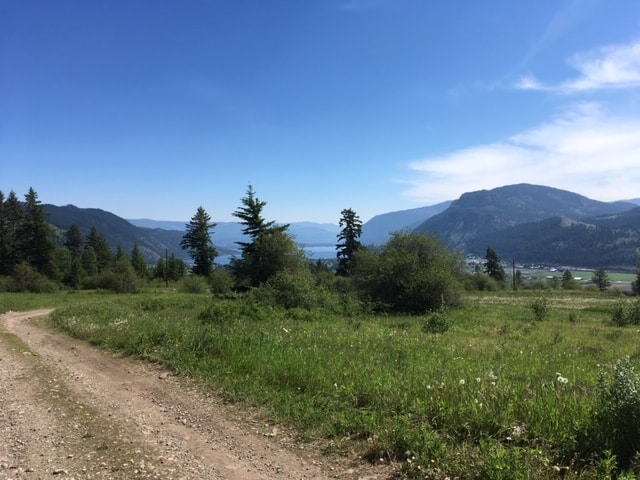Interested in hearing more about how local governments can take action to facilitate community connection to the natural environment? Check out our new Healthy Natural Environments Action Guide. It contains information on the health benefits of natural environments, guidance on incorporating equity in natural environment planning, information on pertinent legislation, and examples of action from B.C. communities.
Revitalizing a healthy natural environment takes a long-term approach that focuses not on a single patch of earth but on surveying the land broadly, looking upstream and reviving knowledge and practices that have been buried.
The Neskonlith are applying this holistic, long-term strategy to improve environmental and community health by developing wide-ranging partnerships and focusing on knowledge sharing. Neskonlith leaders encourage a diverse, multi-sector assembly of allies and invite partnership and collaboration with all types of community groups. They recognize the challenge of improving health inequities in their community, and are embracing incremental change over fixed timelines and expected outcomes, building inclusive processes that grow the well-being of all community members. These processes have led to the rediscovery and re-emergence of traditional farming and land management practices that bring together community members and foster the Neskonlith’s connection to the natural environment and pride in their culture.
Introduction

Neskonlith knowledge holder and band councillor Louis Thomas tilled sections of soil in a Neskonlith meadow. The soil, as in much of his people’s traditional territory, was either compacted by cattle ranching or rendered infertile due to misuse and dormancy. Drier summers have also marked a shift for land that fed thousands of people for thousands of years as Indigenous plants have migrated slowly north and matured smaller in size.
The Neskonlith Indian Band, a First Nations community located in south central BC, is seeking to revitalize access to that land, improve community health and bring together a people displaced by colonialism. Led by knowledge holders Louis Thomas and Duane Manuel and with the help of 2018/19 PlanH funding and BC Healthy Communities planning supports, the Neskonlith are working toward an Indigenous Plant Stewardship Strategy. The purpose of the strategy is to engage with community members and grow relationships with external collaborators such as Interior Health Authority, the First Nations Health Authority and member organizations of the Shuswap Trails Regional Roundtable. These relationships will support the development of future collaborative projects focused on improving community health outcomes and eco-cultural restoration and connecting people to their culture and community.[1]
Today’s Landscape
Like many Indigenous cultures, traditional Neskonlith food systems and environmental care have been repressed along with much of their knowledge. Residential schools and assimilation to capitalist markets forced the Neskonlith to adapt their Indigenous cultivation practices to be successful within the new colonial food system. The reserve system and land pre-emptions for settler farms made traditional territories inaccessible to the Neskonlith and rejected sustainable and land-enhancing Indigenous management practices. Resource extraction industries and modern-day pollutants have led to a changing climate, exacerbating the challenge the Neskonlith and other Secwepemc people, face in accessing water for irrigation amid land appropriation and competing use.[2] These impacts have led to a cycle of mismanagement of the land, which has altered the Neskonlith’s natural environment to a state less capable of producing the variety and volume of crop it once did.
These practices continue to limit the Neskonlith’s activity in their natural environment. Relative to previous generations, little information about Indigenous plants is known. This means that as more Indigenous plant knowledge is revived or learned, even more questions have tended to follow. When restored harvesting areas and ecosystems once again allow for larger-scale Indigenous plant cultivation, it will likely occur in additional places and methods than generations past. To ready themselves, the Neskonlith are working with the Ministry of Agriculture to monitor these changes and seek solutions.
Many, including Thomas, take it upon themselves to challenge the Neskonlith’s inaccessibility to traditional crop cultivating and cultural spaces. Thomas has embraced the communal aspect of food, reviving Indigenous plants and agricultural practices once championed by the Neskonlith, as a way to help his community members reconnect with their culture and improve their environmental and community health. He is determined to build positive and productive relationships moving forward, and the Neskonlith are increasing their community capacity by building partnerships with other Indigenous and non-Indigenous peoples. These partners are welcome to help in the revitalization native plants and traditional agricultural practices, as long as they do so respectfully and reciprocally.
Guiding Principles

The Neskonlith Indian Band encompasses three reserves bordering the Village of Chase and City of Salmon Arm in south central British Columbia. The band is one of five Sexqéltkemc te Secwépemc communities (Secwepemc people of the Lakes region) whose traditional territory includes the lands in and around the South Thompson River and three large lakes, the Shuswap, Adams and Mara lakes.[3]
The Neskonlith worked hard to create a sustainable natural environment that once supported their community with enough native plants to produce food and medicine and contributed to their culture for tens of thousands of people. Scwicw (yellow avalanche lily), Skwekwíne (western spring beauty), Xwtállp (cow parsnip), Ckwalkwalús (wapato), Saskatoon and huckleberries grew naturally, yet it was sustainable cultivation, harvesting and replenishment by the Neskonlith that helped the land and its people thrive. Relationships with other Nations allowed the Neskonlith to leverage their farming knowledge and trade crops and culture with other Sexqéltkemc te Secwepemc (Secwepemc people of the Lakes Region) and Okanagan bands.
These supportive relationships were guided by Stsptekwll (legends that teach) and slexéy̓e (personal stories) handed down by community Elders since time immemorial. Stsptekwll and slexéy̓e contain timeless lessons that remind people to treat the plants, animals, and each other with kindness and respect. These are principles that Thomas uses for motivation and guidance in his work today.
Connecting Community Members
The Neskonlith’s Indigenous Plant Stewardship team is taking an active approach to increasing their community’s champions and building their knowledge base by engaging youth and elders. This effort is vital for preserving the remaining traditional plant knowledge and agricultural practices.
Many community members have regular, full-time jobs, which often leaves them without spare time and energy to contribute to stewardship of plants. By engaging youth and elders, the stewardship team not only retains and regenerates knowledge, it addresses this capacity deficit.
Thomas and Manuel have found traditional plant revitalization projects to be unifying. Across the Shuswap, the significance of the work is being recognized; nearly everyone, including elected Chief and Councils, has a vested interest in maintaining Indigenous culture. While money or land issues can be contentious, Indigenous plants and food serve as an agreeable topic. The Indigenous Plant Stewardship strategy brings Neskonlith members together to learn with one another and builds constructive relationships with other Sexqéltkemc te Secwepemc peoples.
Growing Alliances

The Neskonlith community has grown to include people, places and practices not originally Indigenous to the region, and the Neskonlith are now partnering with non-Indigenous groups and creating mutually beneficial relationships by building trust and shared learning.
Thomas and others leading local plant and environmental revitalization recognized that work of that kind could benefit people beyond the Neskonlith not only those living in other Indigenous communities, but also non-Indigenous communities and groups.
Unearthing traditional plant and environmental knowledge can be invaluable to improving settler society’s current relationship with the land. In order to work toward reconciliation with Indigenous people and live equitably, settlers must honour alternative ways of land stewardship and be willing to return these spaces to their Indigenous caretakers.
In July 2019, the Neskonlith teamed up with the Salmon Arm Arts Centre to host a feast that featured primarily Indigenous plants and foods. The feast was impressive, yet harvesting enough crop to feed approximately 30 people was challenging, serving as a reminder of how far-removed the Neskonlith are from its traditional land and food systems that used to feed thousands.
One way the Neskonlith have begun to re-establish the knowledge base that at one time produced large quantities of food is by partnering with the Shuswap Trail Alliance to map the land and identify areas containing Indigenous plants. Led by Phil McIntyre-Paul, the Trail Alliance is a society of mountain bikers, hikers and skiers who travel deep into the territories of the Sexqéltkemc te Secwepemc. Members act as extra sets of eyes, collaborating with the Neskonlith to alert the Indigenous Plant Stewardship leaders of crop-producing locations that could be geo-referenced. The Neskonlith are designing a field guide of Secwepemc plants to be used by the community, including Trail Alliance members, to help people identify plants when out on the trails.
A strong connection to the natural environment is commonplace with recreationalists, but it rarely results in a communicative, mutually beneficial relationship with the land’s Indigenous stewards. For their part, the Shuswap Trail Alliance has demonstrated itself to be a true advocate for building respectful and trusting working relationships with the Neskonlith.
In 2014, the Shuswap Trails Roundtable was formed to help regional trail interest groups and local Indigenous communities collaborate. Today, that roundtable includes more than 70 leaders and representatives from Secwepemc, local, regional and provincial governments, trail user groups, tourism, environmental stewardship, industry and health organizations. Its annual strategy was shaped by Secwepemc leadership and values, including Y’icwetsutce, the traditional concept and practice of taking care of the land.[4]
Based on participatory, relationship-based community development, this multi-sectoral group includes organizations one may not expect in a recreational trail meeting, like Interior Health Authority. As Anita Ely, an environmental health officer, explains, community health is inextricably linked to the quality and accessibility of the natural environment as well as the quality and accessibility of communities’ relationships. Though Ely doesn’t provide input on trail design, she is a roundtable member, a long-time Salmon Arm resident and a regular presence in these community-based forums. She works to connect people with one another and makes her knowledge and Interior Health’s supports and resources more easily accessible for the entire community.
Indigenous leaders and communities are often asked to share their stories and information so that outsiders can learn and benefit from Indigenous practices; however, this one-sided knowledge sharing helps perpetuate power imbalances and knowledge appropriation. Since 2016, the University of Victoria has addressed this inequity by placing a master’s student in Salmon Arm to work with the Neskonlith to “research the intersections of land-based education, health and well-being, language revitalization and Indigenous food sovereignty.”[5] This student brought an authenticity and earnestness to learning from, and with, the Neskonlith, over time becoming a respected and valuable asset to the Indigenous Plant Stewardship Strategy and the community.
Determining how much modern science and practice should be incorporated into the revitalization of plants and diet also presents new questions the Neskonlith are working to answer. For example, what is the role of modern-day dehydrators in overwinter storage of crops? What effect does it have on the food; what nutritional value is lost?
Shifting Tastes

The Indigenous Plant Stewardship Strategy is engaging the Neskonlith community in a greater cultural resurgence, acting as a mechanism to facilitate additional community health benefits including nutrition, physical activity and mental well-being.
Much of the staple of the Neskonlith diet has traditionally come from root crops and other hearty plants. Unheard of prior to colonialism, chronic diseases such as diabetes are a direct result of the shift away from these traditional foods and toward refined, higher-sugar diets. Reintroducing Indigenous plants as a staple in the Neskonlith diet is key to recalibrating palates toward healthier, natural options.
The Indigenous Plant Stewardship Strategy also promotes physical activity and mental wellness. The identification, cultivation and harvesting of traditional food sources gets people up, out and moving on the land. Throw in a pick and suddenly the work becomes physically demanding while also engaging people with the land in a way that today’s exercise and gym routines do not. Being immersed in nature also brings emotional and mental benefits including the reduction of stress, anxiety and depression.[6] These are benefits the Neskonlith would have innately experienced, had historical and persistent barriers not removed them from their natural environments.
For these reasons, Thomas finds it vital to continue collaborating, partnering and educating predominately non-Indigenous peoples about the injustices that continue to be perpetuated against his people. Over time, the community has become more educated in the wrongdoing local Indigenous communities faced and continue to face and has become increasingly interested in involving themselves in positive change.
Conclusion
The Neskonlith’s Indigenous plant and natural environment revitalization work is a small chapter in a much longer story. The project is not just about food; it’s about a resurgence of the values that stood on Neskonlith land for thousands of years before colonialism tried to tear them down. At one time, the Neskonlith way of life fed more than 10,000 people; its system of values has stood for thousands of years holding a true, mutual relationship with its land, water and air.
By creating an Indigenous Plant Stewardship Strategy, the Neskonlith band has chosen to cultivate not just food, but also relationships and learning opportunities. Sharing traditional knowledge is a strong footing for improving community access and awareness of the natural environment and community health. As interest and community appetite continue to grow, the Neskonlith look forward to requiring a bigger table. As Thomas likes to say, it’s once again time his people start “eating their culture.”
Here are some questions to consider for local governments looking to engage in this type of work:
- What are the key groups in your community that you would like to initiate strengthen a partnership with?
- Do you already have a relationship with your relevant health authority partners?
- What other sectors or departments hold valuable information that might be overlooked in your work due to title or profession?
- Can you think of topics in your work/community of which nearly everyone agrees on an outcome? How can you use this agreement to find common ground in other areas?
- Have you taken the time to think critically about how inequity in the social determinants creates uneven health outcomes in your community?
- Can you think of an example in your work where taking more time to build a stronger process would have allowed for better results in the long term?
[1] Neskonlith PlanH Grant Application (2018).
[4]http://www.shuswaptrailalliance.com/userfiles/file/Shuswap_Trails_Roundtable_13Feb2019_DRAFT_SUMMARY.pdf
[6] Wood, Lisa et al. Public green spaces and positive mental health – investigating the
relationship between access, quantity and types of parks and mental wellbeing. Health & Place 48. 2017




